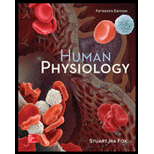
Human Physiology
15th Edition
ISBN: 9781259864629
Author: Fox, Stuart Ira
Publisher: Mcgraw-hill Education,
expand_more
expand_more
format_list_bulleted
Concept explainers
Question
Chapter 1, Problem 9CP
Summary Introduction
To review:
The basic differences between the extracellular and intracellular compartments along with their significance.
Introduction:
In a human body, the total fluid present can be divided into three compartments: extracellular, intracellular,and interstitial fluids. To accommodate these fluids, there are two respective compartments: extracellular and intracellular compartments. Extracellular fluid and interstitial fluid are both enclosed inside the extracellular compartment but the fluid which is present inside the cell is enclosed inside the intracellular compartment.
Expert Solution & Answer
Want to see the full answer?
Check out a sample textbook solution
Students have asked these similar questions
glg 112 mid unit assignment Identifying melting processes
Give only the mode of inheritance consistent with all three pedigrees and only two reasons that support this, nothing more, (it shouldn't take too long)
O
Chapter 1 Solutions
Human Physiology
Ch. 1 - How has the study of physiology aided, and been...Ch. 1 - Describe the steps involved in the scientific...Ch. 1 - Describe the different types of trials a new drug...Ch. 1 - Define homeostasis and describe how this concept...Ch. 1 - Define negative feedback and explain how it....Ch. 1 - Prob. 4CPCh. 1 - Explain how the secretion of a hormone is...Ch. 1 - List the four primary tissues and describe the...Ch. 1 - Compare and contrast the three types of muscle...Ch. 1 - Describe the different types of epithelial...
Ch. 1 - Prob. 7aCPCh. 1 - Describe the different types of connective tissues...Ch. 1 - State the location of each type of primary tissue...Ch. 1 - Describe the functions of nervous, muscle, and...Ch. 1 - Describe the functions of the epidermis and...Ch. 1 - Prob. 9CPCh. 1 - Glands are derived from...Ch. 1 - Cells joined tightly together are characteristic...Ch. 1 - Cells are separated by large extracellular spaces...Ch. 1 - Blood vessels and nerves are usually located...Ch. 1 - Most organs are composed of...Ch. 1 - Sweat is secreted by exocrine glands. This means...Ch. 1 - Which of these statements about homeostasis is...Ch. 1 - In a negative feedback loop, the effector produces...Ch. 1 - A hormone called parathyroid hormone acts to help...Ch. 1 - Which of these consists of dense parallel...Ch. 1 - Prob. 11RACh. 1 - Prob. 12RACh. 1 - Describe the structure of the various epithelial...Ch. 1 - Compare bone, blood, and the dermis of the skin in...Ch. 1 - Describe the role of antagonistic negative...Ch. 1 - Using insulin as an example, explain how the...Ch. 1 - Describe the steps in the development of...Ch. 1 - Why is Claude Bernard considered the father of...Ch. 1 - Prob. 19RACh. 1 - Prob. 20RACh. 1 - Why are interactions between the body-fluid...Ch. 1 - Prob. 22RACh. 1 - Give examples of adult stem cells and explain...Ch. 1 - Prob. 24RACh. 1 - Prob. 25RACh. 1 - Prob. 26RA
Knowledge Booster
Learn more about
Need a deep-dive on the concept behind this application? Look no further. Learn more about this topic, biology and related others by exploring similar questions and additional content below.Similar questions
- Describe the principle of homeostasis.arrow_forwardExplain how the hormones of the glands listed below travel around the body to target organs and tissues : Pituitary gland Hypothalamus Thyroid Parathyroid Adrenal Pineal Pancreas(islets of langerhans) Gonads (testes and ovaries) Placentaarrow_forwardWhat are the functions of the hormones produced in the glands listed below: Pituitary gland Hypothalamus Thyroid Parathyroid Adrenal Pineal Pancreas(islets of langerhans) Gonads (testes and ovaries) Placentaarrow_forward
- Describe the hormones produced in the glands listed below: Pituitary gland Hypothalamus Thyroid Parathyroid Adrenal Pineal Pancreas(islets of langerhans) Gonads (testes and ovaries) Placentaarrow_forwardPlease help me calculate drug dosage from the following information: Patient weight: 35 pounds, so 15.9 kilograms (got this by dividing 35 pounds by 2.2 kilograms) Drug dose: 0.05mg/kg Drug concentration: 2mg/mLarrow_forwardA 25-year-old woman presents to the emergency department with a 2-day history of fever, chills, severe headache, and confusion. She recently returned from a trip to sub-Saharan Africa, where she did not take malaria prophylaxis. On examination, she is febrile (39.8°C/103.6°F) and hypotensive. Laboratory studies reveal hemoglobin of 8.0 g/dL, platelet count of 50,000/μL, and evidence of hemoglobinuria. A peripheral blood smear shows ring forms and banana-shaped gametocytes. Which of the following Plasmodium species is most likely responsible for her severe symptoms? A. Plasmodium vivax B. Plasmodium ovale C. Plasmodium malariae D. Plasmodium falciparumarrow_forward
- please fill in missing parts , thank youarrow_forwardplease draw in the answers, thank youarrow_forwarda. On this first grid, assume that the DNA and RNA templates are read left to right. DNA DNA mRNA codon tRNA anticodon polypeptide _strand strand C с A T G A U G C A TRP b. Now do this AGAIN assuming that the DNA and RNA templates are read right to left. DNA DNA strand strand C mRNA codon tRNA anticodon polypeptide 0 A T G A U G с A TRParrow_forward
arrow_back_ios
SEE MORE QUESTIONS
arrow_forward_ios
Recommended textbooks for you
 Human Biology (MindTap Course List)BiologyISBN:9781305112100Author:Cecie Starr, Beverly McMillanPublisher:Cengage Learning
Human Biology (MindTap Course List)BiologyISBN:9781305112100Author:Cecie Starr, Beverly McMillanPublisher:Cengage Learning Human Physiology: From Cells to Systems (MindTap ...BiologyISBN:9781285866932Author:Lauralee SherwoodPublisher:Cengage Learning
Human Physiology: From Cells to Systems (MindTap ...BiologyISBN:9781285866932Author:Lauralee SherwoodPublisher:Cengage Learning Anatomy & PhysiologyBiologyISBN:9781938168130Author:Kelly A. Young, James A. Wise, Peter DeSaix, Dean H. Kruse, Brandon Poe, Eddie Johnson, Jody E. Johnson, Oksana Korol, J. Gordon Betts, Mark WomblePublisher:OpenStax College
Anatomy & PhysiologyBiologyISBN:9781938168130Author:Kelly A. Young, James A. Wise, Peter DeSaix, Dean H. Kruse, Brandon Poe, Eddie Johnson, Jody E. Johnson, Oksana Korol, J. Gordon Betts, Mark WomblePublisher:OpenStax College

Human Biology (MindTap Course List)
Biology
ISBN:9781305112100
Author:Cecie Starr, Beverly McMillan
Publisher:Cengage Learning

Human Physiology: From Cells to Systems (MindTap ...
Biology
ISBN:9781285866932
Author:Lauralee Sherwood
Publisher:Cengage Learning



Anatomy & Physiology
Biology
ISBN:9781938168130
Author:Kelly A. Young, James A. Wise, Peter DeSaix, Dean H. Kruse, Brandon Poe, Eddie Johnson, Jody E. Johnson, Oksana Korol, J. Gordon Betts, Mark Womble
Publisher:OpenStax College
